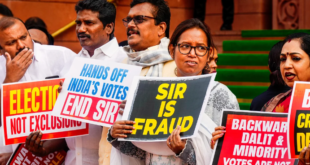 Dr. Seema Javed
Dr. Seema Javed
The monsoon rainfall exhibits a strong relationship with the El Niño, but is different across regions over India and has varied over timeframes during the last century, reports a study led by Roxy Mathew Koll of the Indian Institute of Tropical Meteorology (IITM), Pune.
In the study published in the journal Scientific Reports, the researchers report a significant change in El Niño–monsoon relationship over the north, central, and south India. They find that while the El Niño–monsoon relationship has stayed moderately strong and stable for south India, it has become exceptionally stronger over time for north India, while it has considerably weakened and become non-existent over the central Indian region (core monsoon zone) in the recent decades.
El Niño–monsoon relationship The Indian monsoon has waxed and waned over time. The year-to-year fluctuations of the monsoon are largely modulated by the fluctuations in ocean temperatures in the Pacific. These oscillations in the Pacific Ocean are dominated by the El Niño and La Niña, the warm and cool water phases in the central-east Pacific, known as the El Niño Southern Oscillation (ENSO).
Generally, an El Niño event weakens the trade winds that blow across the Pacific. These trade
winds are connected to the moisture-laden monsoon winds over India, and thereby dampens the
monsoon too, reducing rainfall over the Indian subcontinent. Historically, at least half of the El
Niño years were monsoon droughts (where the All-India monsoon rainfall is less than 10% of the
long-term average).
Regional variability over time
The ENSO impact over the Indian subcontinent is not the same everywhere. The relationship
between ENSO and monsoon has not remained the same throughout the period from 1901 to the
present. We notice that the ENSO–monsoon relationship started getting stronger from 1901 to
1940, became stable from 1941 to 1980 and then the relationship has weakened in the recent
period (1981 onwards).

These changes in the ENSO–monsoon relationship are regionally non-uniform. Over south India,there is no considerable variation in the ENSO–monsoon relationship. Whereas over north Indiathe ENSO–monsoon relationship is becoming strong in recent decades. On the contrary, association between the rainfall over central India (core monsoon zone) and ENSO has diminished in the recent decades.
The monsoon rainfall is also influenced by the strength of the monsoon trough and related
changes in monsoon depressions. The monsoon trough and depression related variability has
emerged as the primary cause of rainfall variability over central India, surpassing the dominance
of ENSO. For the rainfall over south India, the influence of ENSO and strength of monsoon trough and depressions have been consistent over the entire period. Over north India, rainfall variability is increasingly dependent on ENSO, while the role of the monsoon trough and depressions is decreasing.
This may be due to the decreasing strength of the monsoon due to Indian Ocean warming, and the weakening reach of the monsoon depressions into the north Indian region in recent decades.
The way forward “Monsoon seasonal prediction depends a lot on how the El Niño is simulated by the forecast model. A strong and steady ENSO-monsoon correlation over north and south India means that this relationship can be used for improved monsoon forecasts over these regions.
Meanwhile, we should note that the ENSO dominance over the core monsoon zone is weak, which means that seasonal prediction over this region has become less predictable in the recent decades. Other factors like Indian Ocean warming should be monitored for the core monsoon zone, due to its impact on the strength of the monsoon trough and the depressions.” said Koll.
“This year so far, the impact of ENSO is limited as the atmospheric teleconnection is weak, but the impact of El Nino might be more dominant in the second half of the monsoon.”, said Vineet Kumar Singh, co-author of the study. The research was conducted by Athira K.S., Panini Dasgupta, Saranya J.S., and Vineet Kumar Singh at IITM, Pune, under Koll’s guidance, in collaboration with Raju Attada at IISER Mohali.
 Jubilee Post News & Views
Jubilee Post News & Views





